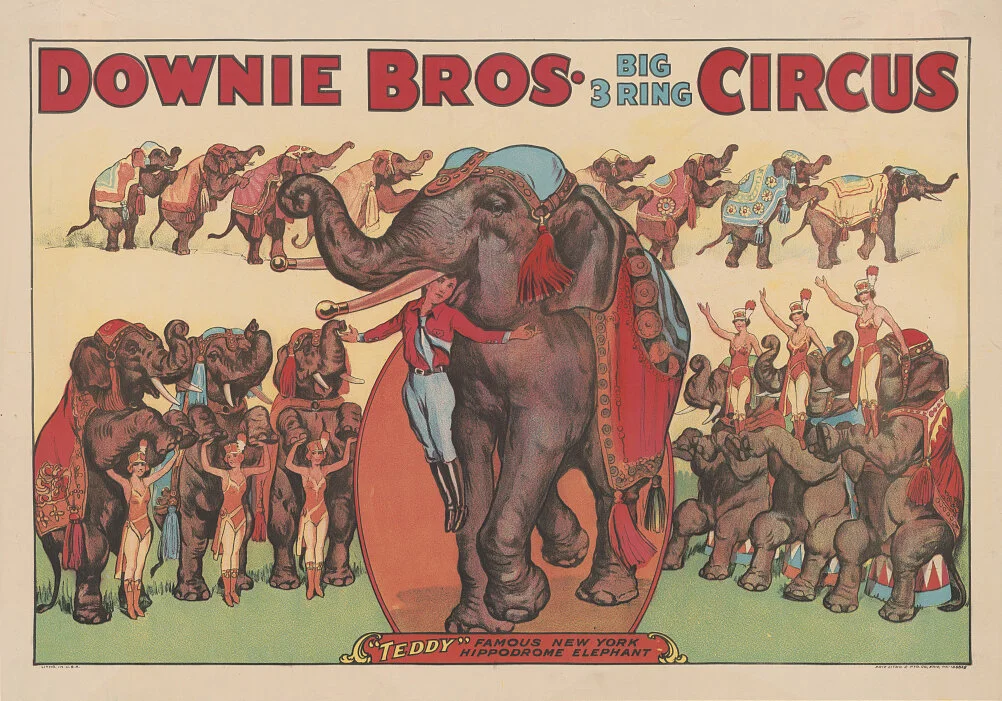Poster advertising Barnum and Bailey’s Greatest Show on Earth, featuring trick-riders, circa 1900. Courtesy of the Library of Congress
The modern circus as we know it was developed in the 18th century and was based on the equestrian sport of trick-riding. These riders usually performed in a circular arena known as a “circus,” derived from the Latin word for “circle.” Many of the stunts performed by trick-riders depended on centrifugal force created by the swiftly moving horses, which allowed the riders to balance more easily while standing on the backs of the animals.
Lynchburg had its share of travelling equestrian performers. As early as 1818, a trick-rider named Master Carnes advertised that he would perform feats on horseback. Sometime after this, an equestrian company established itself in a vacant lot near Dr. John Cabell’s house on Main Street between Fifth and Sixth Streets. They performed in town for the entire season, only leaving when the winter weather began.
In Great Britain in 1770, a popular trick-rider named Phillip Astley began using jugglers, acrobats, and clowns to fill time between the equestrian performances. His London shows gained popularity, and in 1782, Astley opened Paris’s first circus, the Amphithéâtre Anglois. That same year, a competitor and former employee of Astley opened the Royal Circus and Equestrian Philharmonic Academy in London.
Circuses in Europe were performed in temporary wooden structures, but by the early 19th century many cities had permanent circus arenas. North America had permanent circuses in New York, Philadelphia, Mexico City, and Montréal by 1802. The United States was still a developing country during this time, and many settlers were travelling west. The country was mostly made of small, scattered settlements with few cities large enough to maintain a permanent circus. Businessmen saw the opportunity to make money, and soon the travelling circus was born.
The Lynchburg Daily Virginian, November 1888 - Note the Mention of Martinho Lowande, Sr.
Martinho Lowande and his two sons, 1877, Australia, by Arthur W. Burman. Purchased 2014. Te Papa (O.042714)
https://collections.tepapa.govt.nz/object/1450698
American circuses began to look and operate very differently from their European counterparts. In the 1820’s, they began using canvas tents instead of wooden structures. Many circuses in the United States featured menageries of animals, while in Europe circuses were still primarily equestrian shows. Perhaps the biggest difference was who was in control: in Europe, many shows were owned by performing families, while in America they were run by men only in the business to make money. Throughout the 19th century, entrepreneurs from around the world copied the American style of circus and brought the travelling tents to Europe, Asia, and South America.
Throughout the mid-19th century, performances evolved with popular culture. Originally, equestrian trick-riders were the main attractions, but over the years the focus shifted to tight-rope dancers. These performers had been popular at fairs for centuries and began making their way into the world of the circus acrobat. To perform in the circus, tight-rope dancers had to create new and exciting acts. They began swinging from ropes and horizontal bars, eventually becoming an entirely new type of performer: the trapeze artist. Exotic animals, like big cats and elephants, became the featured animals instead of trained horses. The older, more traditional equestrian focused show had completely changed.
Trapeze artists above a circus, circa 1890, courtesy of the Library of Congress
In the 21st century the circus is undergoing another major transformation. Increasing pressure to stop using exotic animals has shifted the focus of many shows heavily towards acrobatics, which is now understood to be a formal performing art. Many who study this discipline train in permanent academies like the Philadelphia School for Circus Arts and Circus Arts Conservatory in Sarasota, Florida. Another popular feature of America’s circus tradition is the “freak show,” which is alive and well in places like Coney Island, in travelling acts, and on television. In 2018, Lynchburg hosted the Venardos Circus, which featured acrobats, jugglers, comedy shows, and more.

